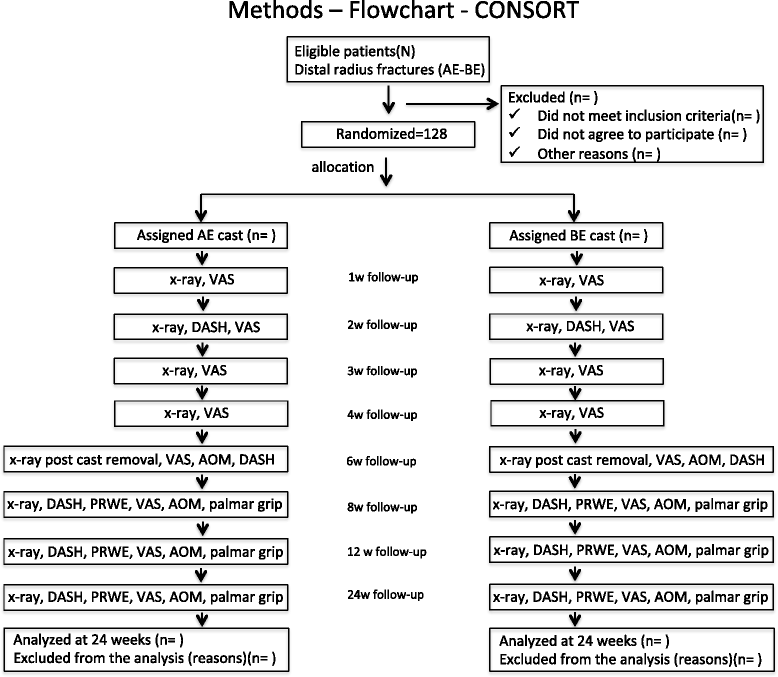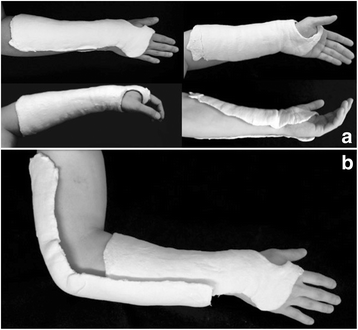Above-versus below-elbow casting for conservative treatment of distal radius fractures: a randomized controlled trial and study protocol
- PMID: 29587687
- PMCID: PMC5870077
- DOI: 10.1186/s12891-018-2007-9
Above-versus below-elbow casting for conservative treatment of distal radius fractures: a randomized controlled trial and study protocol
Abstract
Background: A variety of cast options are available for the non-surgical treatment of distal radius fractures (DRF) in adults. However, the literature is inconclusive regarding the need to immobilize the elbow joint after reduction in order to prevent rotation of the forearm in order to maintain the reduction of DRF. This study aimed to evaluate the best method of immobilization between above-elbow (AE) and below-elbow (BE) cast groups at the end of six-month follow-up.
Methods: This is a randomized clinical trial with parallel groups and a blinded evaluator. There are two non-surgical interventions: AE and BE. Patients will be randomly assigned. A hundred twenty eight consecutive adult patients with acute (up to 7 days) displaced DRF of type A2, A3, C1, C2 or C3 by the Arbeitsgemeinschaft für Osteosynthesefragen (AO) classification will be included. The primary outcome will be the maintenance of reduction by evaluation of radiographic parameters and Disabilities of the Arm, Shoulder and Hand Questionnaire (DASH). Secondary outcomes include function measured by Patient Rated Wrist Evaluation (PRWE), pain measured by the Visual Analogue Scale (VAS), objective functional evaluation (goniometry and dynamometry) and rate of complications. Evaluations will be performed at 1, 2, 3, 4, 6, 8, 12 and 24 weeks. For the Student's t-test, a difference of 10 points in DASH score, with 95% confidence interval, a statistical power of 95%, and 20% sampling error. We consider an extra 10% for balancing follow up losses results in 64 patients per group.
Discussion: Results from this study protocol will help to define the need for elbow immobilization in maintenance of reduction, as well as functional performance of below elbow cast versus above elbow cast immobilization during the immobilization period.
Trial registration: NCT03126175 ( http://clinicaltrials.gov ). April 24, 2017.
Keywords: Conservative treatment; Distal radius fracture; Prospective; Randomized; Treatment outcome.
Conflict of interest statement
Ethics approval and consent to participate
The Regional Ethics Committee of UNIFESP and Hospital Municipal Dr. Fernando Mauro Pires da Rocha have approved the trial and additional papers, including consent form and patient information sheet. Approval number: CAAE 57857216.8.0000.5505 and 57857216.8.3001.5452.
Consent for publication
Not applicable.
Competing interests
The authors declare that there are no conflicts of interest.
Publisher’s Note
Springer Nature remains neutral with regard to jurisdictional claims in published maps and institutional affiliations.
Figures
References
-
- Handoll H, Madhok R. Conservative interventions for treating distal radial fractures in adults. Cochrane Database Syst Rev. 2003;2(2):CD000314. - PubMed
Publication types
MeSH terms
Associated data
LinkOut - more resources
Full Text Sources
Other Literature Sources
Medical
Miscellaneous



